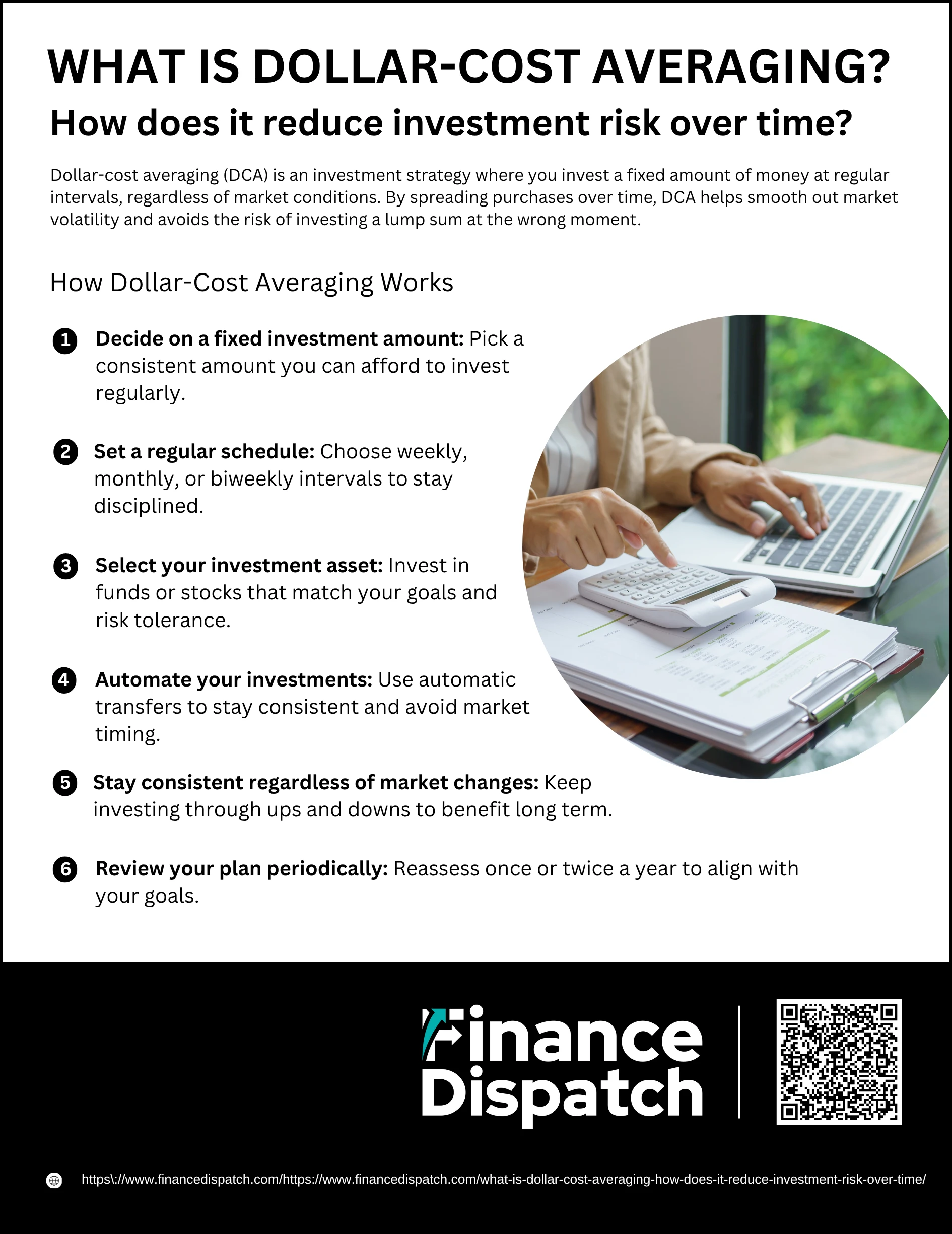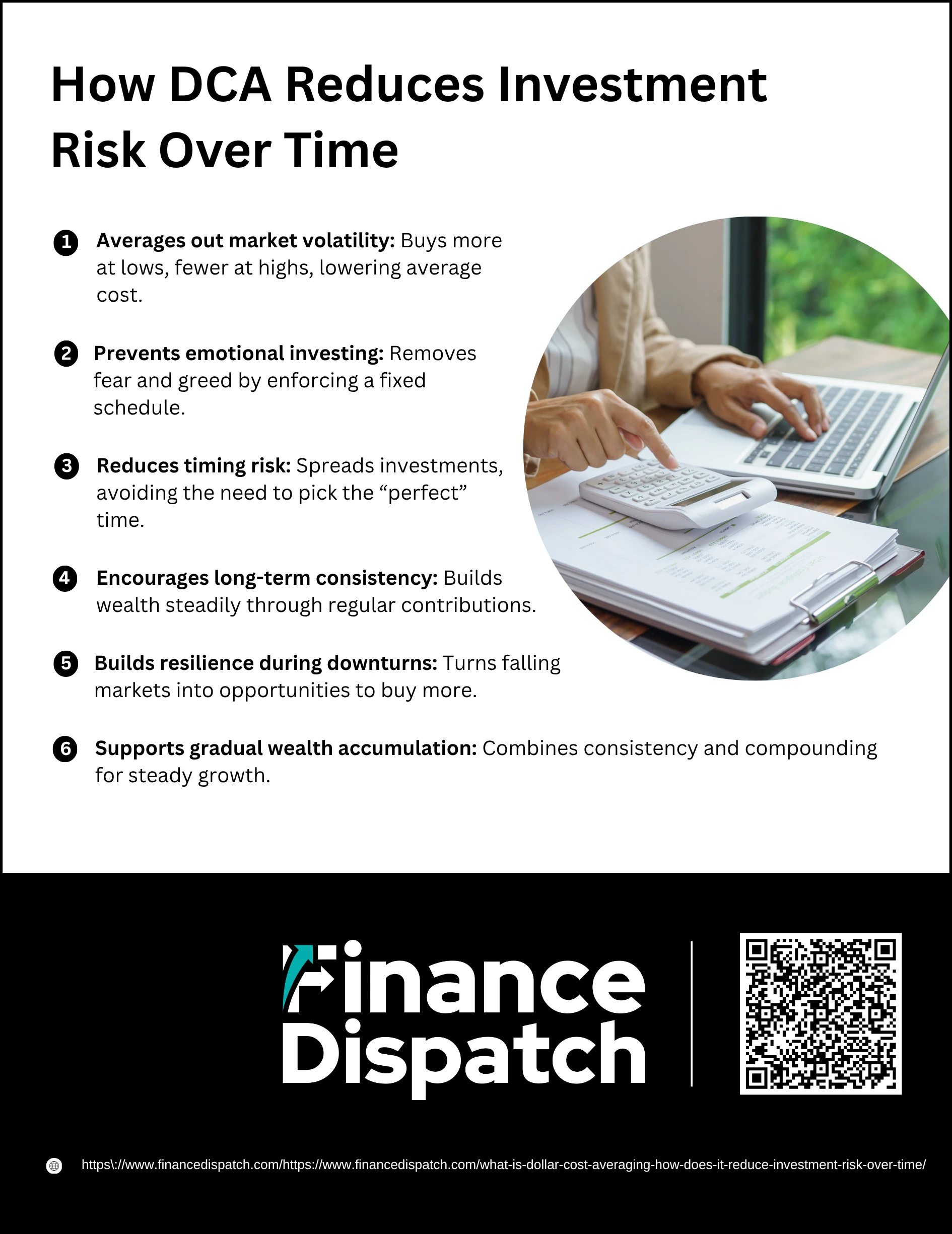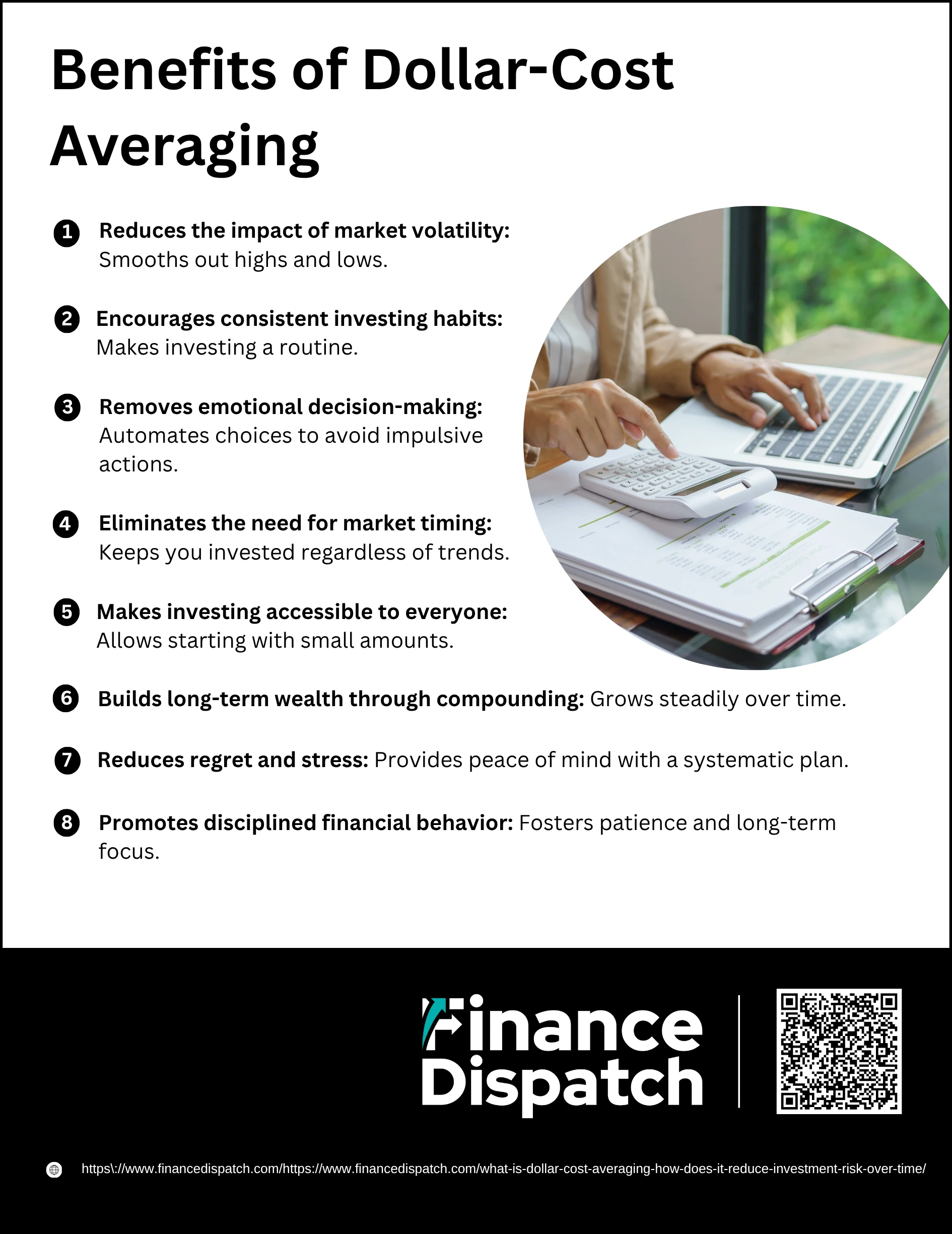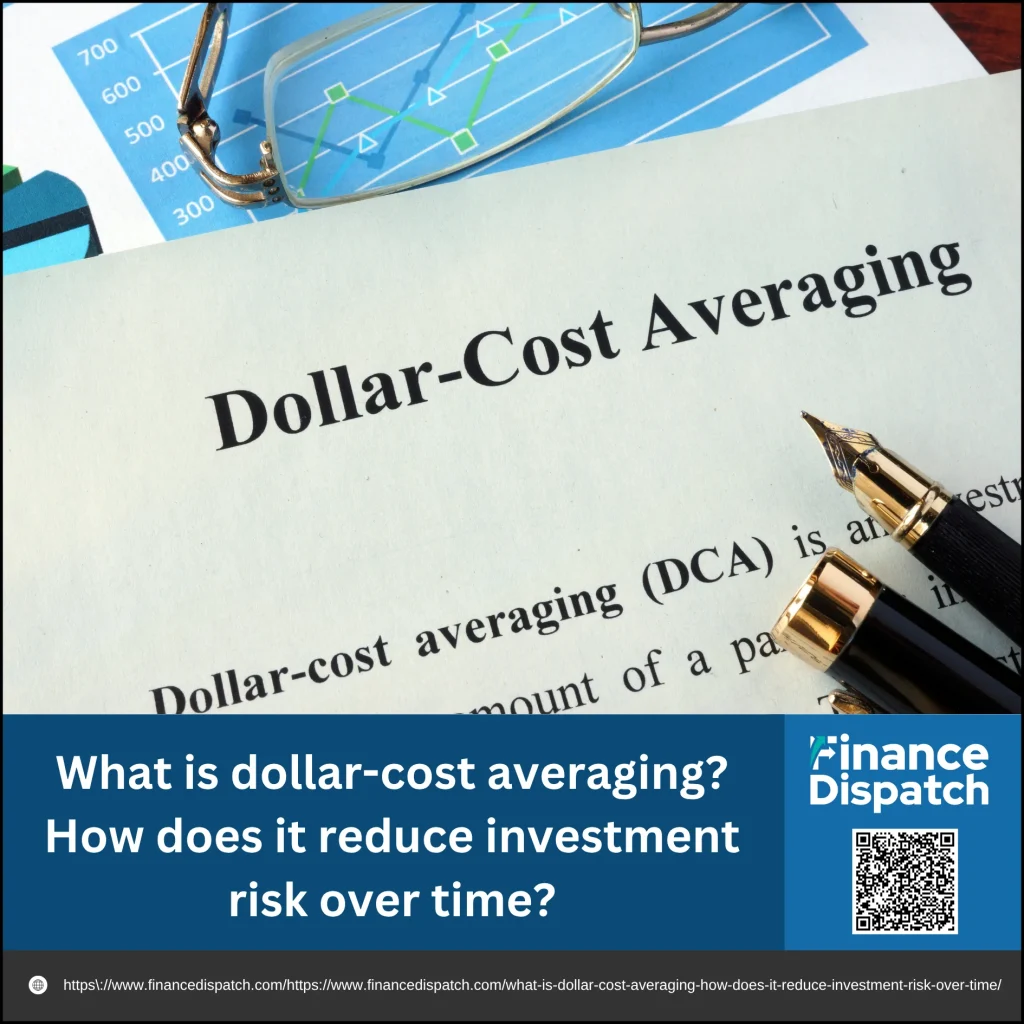Investing can often feel like walking a tightrope — balancing between the fear of market drops and the temptation to chase rising prices. Even seasoned investors struggle with predicting the perfect time to buy or sell. This uncertainty is where dollar-cost averaging (DCA) steps in as a steady, disciplined approach to investing. Instead of trying to time the market, DCA focuses on investing a fixed amount of money at regular intervals, regardless of market conditions. Over time, this consistent strategy helps smooth out the impact of market volatility, lowers the average cost per share, and allows you to build wealth gradually while reducing emotional decision-making. By sticking to a routine investment schedule, DCA helps take the guesswork — and the stress — out of investing.
What Is Dollar-Cost Averaging (DCA)?
Dollar-cost averaging (DCA) is a long-term investment strategy designed to eliminate the pressure of timing the market. Instead of investing a large sum all at once, you invest a fixed amount of money at regular intervals — whether weekly, monthly, or quarterly — regardless of how the market is performing. This means that when prices are high, your fixed amount buys fewer shares, and when prices drop, it buys more. Over time, this approach helps reduce the average cost per share, smooth out the effects of market fluctuations, and build a disciplined investing habit. By focusing on consistency rather than prediction, DCA allows investors to participate in the market continuously and minimize the emotional reactions that often lead to costly mistakes.
 How Dollar-Cost Averaging Works
How Dollar-Cost Averaging Works
Dollar-cost averaging (DCA) is an investing approach built on discipline rather than prediction. Instead of trying to guess when prices will rise or fall, you invest a fixed amount of money at regular intervals — weekly, monthly, or quarterly — regardless of market conditions. When prices drop, you buy more shares for the same amount of money; when prices rise, you buy fewer. Over time, this strategy helps you lower your average cost per share, smooth out the effects of market volatility, and develop a steady investment habit that can lead to long-term wealth growth.
Here’s a detailed look at how each step works in practice:
1. Decide on a fixed investment amount
Start by choosing an amount that fits comfortably within your budget. The key is consistency — whether it’s $50, $100, or $500, your chosen amount should be one you can commit to regularly without straining your finances. This predictable pattern helps build investing discipline and keeps you engaged in the market over time.
2. Set a regular schedule
Decide how often you’ll invest — many investors choose monthly or biweekly intervals, often aligning with their paycheck schedule. Regularity is the foundation of DCA, as it ensures you invest across various market conditions, capturing both highs and lows.
3. Select your investment asset
Choose the type of investment that suits your goals and risk tolerance. Common choices include index funds, exchange-traded funds (ETFs), mutual funds, or even individual stocks. For beginners or cautious investors, diversified funds like ETFs or mutual funds can reduce risk while offering steady growth potential.
4. Automate your investments
Automation removes the temptation to time the market or skip a contribution. Most brokers and financial platforms allow you to set up automatic transfers from your bank account to your investment account on a fixed schedule. This “set it and forget it” approach keeps your plan on track even when market headlines cause panic or excitement.
5. Stay consistent regardless of market changes
One of the biggest advantages of DCA is that it takes emotions out of the equation. During market downturns, many investors panic and stop investing — but DCA encourages you to keep going. Ironically, those lower prices allow you to buy more shares, positioning your portfolio for greater gains when the market recovers.
6. Review your plan periodically
While consistency is key, it’s also important to review your plan occasionally — perhaps once or twice a year. Check whether your investment choices still align with your financial goals, risk tolerance, and time horizon. Avoid reacting to short-term market movements; instead, focus on your long-term objectives and make thoughtful adjustments when needed.
 How DCA Reduces Investment Risk Over Time
How DCA Reduces Investment Risk Over Time
Dollar-cost averaging (DCA) is more than just a saving habit—it’s a powerful tool for reducing investment risk and managing market uncertainty. Instead of investing a lump sum all at once, DCA involves putting in a fixed amount at regular intervals, regardless of price movements. This disciplined approach spreads your investment over time, allowing you to buy more when prices are low and fewer when prices are high. The result is a smoother, more stable growth path that helps protect you from sudden market drops and emotional decision-making. While DCA doesn’t eliminate all market risks, it helps balance them out over the long term, giving you a more predictable and stress-free investing experience.
Here’s a deeper look at how DCA helps reduce investment risk over time:
1. Averages out market volatility
One of the greatest strengths of DCA is how it smooths out the effects of market fluctuations. Since you’re investing the same amount regularly, you automatically buy more shares when prices drop and fewer when prices rise. Over time, this “averaging effect” reduces the overall cost per share. Instead of being hurt by short-term ups and downs, you benefit from them—turning volatility into an advantage. This steady approach helps shield your portfolio from sharp price swings that might otherwise cause panic or losses.
2. Prevents emotional investing
Emotional investing is one of the most common causes of financial losses. Investors often panic when prices fall and rush to buy when markets are high—exactly the opposite of what’s best. DCA eliminates that emotional tug-of-war by enforcing a fixed schedule. Because you invest automatically, your decisions are not influenced by fear, greed, or daily market noise. This consistency helps you stay focused on your long-term goals and reduces the risk of impulsive, costly mistakes.
3. Reduces timing risk
Trying to predict when the market will rise or fall—known as “market timing”—is nearly impossible, even for experts. DCA removes this uncertainty completely. By investing at fixed intervals, you no longer need to worry about buying at the “perfect time.” Instead, your purchases are spread across multiple market conditions, lowering the risk of investing a lump sum right before a downturn. This makes DCA a safer, more reliable strategy for long-term investors.
4. Encourages long-term consistency
Investing success often depends more on consistency than on timing or luck. DCA fosters a disciplined routine where you invest regularly, regardless of market trends. This steady flow of contributions helps you build wealth gradually while keeping you engaged in the market through both good and bad times. The habit of regular investing also aligns perfectly with long-term goals like retirement savings, where persistence matters more than short-term performance.
5. Builds resilience during downturns
Market downturns can be intimidating, but for a DCA investor, they’re actually an opportunity. When prices fall, your regular contributions buy more shares for the same amount of money. These lower-cost shares increase in value when the market eventually recovers, giving your portfolio a stronger rebound effect. By viewing downturns as a chance to accumulate assets rather than a time to retreat, DCA helps you build resilience and stay the course during tough periods.
6. Supports gradual wealth accumulation
Dollar-cost averaging aligns perfectly with the principle of steady, compounding growth. Each small investment builds upon the last, and over time, those contributions—and their returns—begin to compound. This approach minimizes the need for large, risky investments while promoting sustainable wealth accumulation. By combining consistency with compounding, DCA creates a slow but reliable path toward achieving long-term financial stability.
 Benefits of Dollar-Cost Averaging
Benefits of Dollar-Cost Averaging
Dollar-cost averaging (DCA) offers investors a practical and disciplined approach to building wealth without the stress of trying to time the market. By investing a fixed amount at regular intervals, regardless of market conditions, you can reduce the emotional ups and downs that often come with investing. This steady strategy encourages consistency, helps smooth out price fluctuations, and builds confidence over time. Whether you’re a beginner or a long-term investor, DCA can simplify your investment journey while minimizing risk.
Here are the key benefits of using dollar-cost averaging:
1. Reduces the impact of market volatility
DCA helps balance out market highs and lows by spreading your investments over time. You buy more shares when prices are low and fewer when they’re high, which helps lower your average cost per share and minimizes the effect of sudden price swings.
2. Encourages consistent investing habits
By committing to regular contributions, you turn investing into a routine rather than a reaction. This consistency builds long-term financial discipline and ensures your money continues to work for you regardless of market movements.
3. Removes emotional decision-making
Many investors make poor choices driven by fear during downturns or greed during rallies. DCA eliminates the temptation to react impulsively by automating your investment schedule, allowing logic—not emotions—to guide your portfolio.
4. Eliminates the need for market timing
Predicting when to buy or sell is one of the hardest parts of investing. With DCA, you don’t have to guess the right time to enter the market. Investing at regular intervals helps you stay invested through both good and bad times, capturing long-term growth opportunities.
5. Makes investing accessible to everyone
You don’t need a large sum of money to get started. DCA allows you to invest small, manageable amounts over time, making it easier for new investors or those on a budget to participate in the market and grow their wealth gradually.
6. Builds long-term wealth through compounding
Consistent investing, even with smaller amounts, allows your returns to compound over time. As your investments generate earnings, those earnings are reinvested to create even more growth, helping your portfolio expand steadily.
7. Reduces regret and stress
Since DCA doesn’t depend on guessing the “perfect moment” to invest, it helps reduce anxiety about market movements. Knowing you’re following a systematic plan brings peace of mind and prevents second-guessing your investment decisions.
8. Promotes disciplined financial behavior
Over time, DCA fosters a sense of responsibility and patience. It helps investors focus on long-term goals rather than short-term market noise, creating a stable foundation for financial success.
Who Should Use DCA?
Dollar-cost averaging (DCA) is a versatile strategy that can benefit almost any type of investor, but it’s especially useful for beginners, long-term investors, and those who prefer a hands-off approach. If you’re new to investing and uncertain about when to buy, DCA removes the pressure of timing the market by letting you invest steadily over time. For long-term investors, it provides a disciplined way to build wealth gradually while reducing emotional stress during market ups and downs. Risk-averse investors can also benefit from DCA because it spreads out investment risk instead of committing a lump sum at once. However, it may not suit those who prefer short-term trading or who expect markets to rise rapidly in a short period. In essence, DCA is ideal for anyone who values consistency, patience, and a structured path to long-term financial growth.
DCA vs. Lump-Sum Investing
When it comes to investing, one of the most common questions is whether to invest all your money at once or spread it out over time. Dollar-cost averaging (DCA) and lump-sum investing represent two distinct approaches to this decision. While DCA focuses on investing fixed amounts at regular intervals to reduce the impact of market volatility, lump-sum investing involves putting a large amount into the market all at once. Each method has its advantages and drawbacks depending on your risk tolerance, market outlook, and investment goals.
Here’s a comparison to help you understand how they differ:
| Feature | Dollar-Cost Averaging (DCA) | Lump-Sum Investing |
| Investment Method | Invests a fixed amount regularly over time | Invests a large amount all at once |
| Market Timing | Removes the need to time the market | Requires timing the market for best results |
| Risk Exposure | Lower risk—reduces impact of volatility | Higher risk—exposed to short-term market swings |
| Return Potential | Moderate returns; slower growth during rising markets | Higher potential returns if markets rise soon after investing |
| Emotional Impact | Reduces fear and greed; promotes disciplined investing | Can lead to emotional stress if markets drop after investing |
| Ideal For | Beginners, long-term, or risk-averse investors | Experienced investors with higher risk tolerance |
| Cash Utilization | Some funds remain uninvested until future intervals | Entire amount works in the market immediately |
| Market Conditions Best Suited For | Volatile or uncertain markets | Bullish or steadily rising markets |
| Investment Behavior | Encourages consistent, automated investing | Requires active decision-making and confidence |
| Goal | Minimize risk and emotional bias | Maximize potential returns through early exposure |
When DCA May Not Work
While dollar-cost averaging (DCA) is a valuable strategy for managing risk and building wealth steadily, it isn’t foolproof. Like any investment method, its effectiveness depends on market conditions and your financial goals. In certain scenarios, DCA may lead to lower returns or missed opportunities compared to other strategies like lump-sum investing. It’s important to understand these limitations before committing to a DCA plan so you can make informed, flexible investment decisions.
Here are situations where DCA may not work as effectively:
1. In a steadily rising market:
If prices continue climbing over time, spreading investments may result in higher average purchase prices, as later investments buy fewer shares at higher costs.
2. When you have a large lump sum ready to invest:
Keeping money uninvested for long periods can cause missed opportunities for growth, especially in markets trending upward.
3. During periods of low volatility:
If prices remain stable without significant fluctuations, DCA’s advantage of buying at various price points becomes minimal.
4. When transaction fees are high:
Regular investments can lead to multiple small transactions, increasing overall costs and reducing potential returns.
5. If the chosen investment continually declines:
DCA doesn’t protect against losses. Continuously investing in a declining asset without reevaluating its fundamentals can magnify losses.
6. For short-term goals:
DCA is best suited for long-term wealth building. Investors seeking quick returns or short-term profits may find it too gradual to meet their needs.
 How to Start Dollar-Cost Averaging
How to Start Dollar-Cost Averaging
Starting with dollar-cost averaging (DCA) is one of the easiest and most effective ways to begin investing. The process focuses on regularity and discipline rather than market timing. By investing a fixed amount of money at consistent intervals, you can gradually build your portfolio, minimize emotional decision-making, and reduce the impact of short-term market volatility. Whether you’re new to investing or looking for a stable long-term approach, following a few structured steps will help you set up a reliable DCA plan that works toward your financial goals.
Here’s a detailed explanation of each step:
1. Set clear financial goals
Before you start investing, identify why you’re investing. Are you saving for retirement, your child’s education, or long-term wealth growth? Clear goals help define your investment strategy, risk tolerance, and time horizon. For instance, a retirement goal 20 years away allows for higher-risk investments like stocks, while a shorter-term goal might call for more conservative options. Knowing your destination helps shape the entire DCA plan.
2. Determine your investment amount
Decide on a specific amount you can comfortably invest at regular intervals. The key is consistency. Your chosen amount should fit within your budget, ensuring that you can continue investing even when unexpected expenses arise. It’s better to start small and increase contributions over time than to commit too much and stop midway. The goal is to make investing a habit — one that becomes as natural as saving.
3. Choose your investment frequency
DCA works best when your investments follow a consistent schedule, such as weekly, biweekly, or monthly. Many investors align their investment intervals with their paycheck dates to simplify the process. The frequency you choose should depend on your income pattern and comfort level. The more regular your contributions, the smoother your average cost becomes over time.
4. Select your investment assets
Once you’ve established your budget and frequency, choose where to invest your money. Common DCA-friendly assets include mutual funds, index funds, and exchange-traded funds (ETFs) — all of which offer diversification and lower risk compared to individual stocks. Beginners may prefer broad-market funds that track indexes like the S&P 500, while experienced investors can tailor their portfolios with specific sectors or growth stocks. Always match your asset selection to your goals and risk tolerance.
5. Automate your contributions
Automation is the backbone of a successful DCA strategy. By setting up automatic transfers from your bank to your investment account, you ensure that your plan continues without emotional interference. Automation prevents hesitation during market downturns — the times when investing consistently often leads to the best long-term results. Most brokers and investment platforms make automation easy to set up and adjust as your income or goals change.
6. Stay committed during market fluctuations
The market will rise and fall — that’s inevitable. The true strength of DCA lies in sticking with your plan through all conditions. When prices fall, your regular investment buys more shares at lower prices, setting you up for greater gains during recovery. When prices rise, your steady investing ensures you’re still participating in the growth. Avoid the temptation to pause or stop contributions based on short-term performance; DCA rewards patience and consistency.
7. Review your plan periodically
While automation keeps your investments consistent, it’s still important to check your progress periodically. Reviewing your portfolio once or twice a year allows you to ensure it remains aligned with your goals, risk profile, and market changes. You may decide to increase contributions, rebalance your investments, or adjust your asset allocation as your financial situation evolves. However, avoid frequent changes based on market headlines — focus on long-term adjustments backed by your financial plan.
Conclusion
Dollar-cost averaging (DCA) is a simple yet powerful investment strategy that helps you stay consistent, disciplined, and focused on long-term growth. By investing a fixed amount of money at regular intervals, you automatically balance the effects of market ups and downs — buying more when prices are low and less when they’re high. This approach takes the stress out of timing the market, reduces emotional decision-making, and promotes steady wealth accumulation over time. While DCA doesn’t eliminate all investment risks, it transforms volatility into an opportunity and builds confidence through consistency. For anyone seeking a practical, patient, and low-stress way to invest, dollar-cost averaging offers a reliable path toward achieving long-term financial goals.



